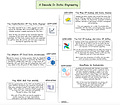The concepts and skills data engineers need to know have been around for decades.
However, the role itself has really only been around for a little over 10 years, with companies like Facebook, Netflix and Google leading the charge.
Throughout those ten years, there were significant breakthroughs and tools through hype, and general acceptance became stand…
Keep reading with a 7-day free trial
Subscribe to SeattleDataGuy’s Newsletter to keep reading this post and get 7 days of free access to the full post archives.

